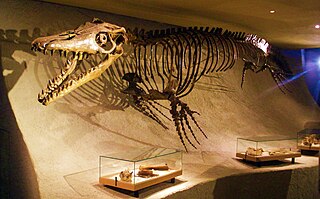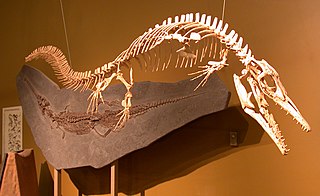
Mosasaurs are an extinct group of large aquatic reptiles within the family Mosasauridae that lived during the Late Cretaceous. Their first fossil remains were discovered in a limestone quarry at Maastricht on the Meuse in 1764. They belong to the order Squamata, which includes lizards and snakes.

Squalicorax, commonly known as the crow shark, is a genus of extinct lamniform shark known to have lived during the Cretaceous period. The genus had a global distribution in the Late Cretaceous epoch. Multiple species within this genus are considered to be wastebasket taxon due to morphological similarities in the teeth.

Mosasaurus is the type genus of the mosasaurs, an extinct group of aquatic squamate reptiles. It lived from about 82 to 66 million years ago during the Campanian and Maastrichtian stages of the Late Cretaceous. The genus was one of the first Mesozoic marine reptiles known to science—the first fossils of Mosasaurus were found as skulls in a chalk quarry near the Dutch city of Maastricht in the late 18th century, and were initially thought to be crocodiles or whales. One skull discovered around 1780 was famously nicknamed the "great animal of Maastricht". In 1808, naturalist Georges Cuvier concluded that it belonged to a giant marine lizard with similarities to monitor lizards but otherwise unlike any known living animal. This concept was revolutionary at the time and helped support the then-developing ideas of extinction. Cuvier did not designate a scientific name for the animal; this was done by William Daniel Conybeare in 1822 when he named it Mosasaurus in reference to its origin in fossil deposits near the Meuse River. The exact affinities of Mosasaurus as a squamate remain controversial, and scientists continue to debate whether its closest living relatives are monitor lizards or snakes.
Platecarpus is an extinct genus of aquatic lizards belonging to the mosasaur family, living around 84–81 million years ago during the middle Santonian to early Campanian, of the Late Cretaceous period. Fossils have been found in the United States and possible specimens in Belgium and Africa. A well-preserved specimen of Platecarpus shows that it fed on moderate-sized fish, and it has been hypothesized to have fed on squid, and ammonites as well. Like other mosasaurs, it was initially thought to have swum in an eel-like fashion, although another study suggests that it swam more like modern sharks. An exceptionally well-preserved specimen of P. tympaniticus known as LACM 128319 shows skin impressions, pigments around the nostrils, bronchial tubes, and the presence of a high-profile tail fluke, showing that it and other mosasaurs did not necessarily have an eel-like swimming method, but were more powerful, fast swimmers. It is held in the Natural History Museum of Los Angeles County. Isotopic analysis on teeth specimens has suggested that this genus and Clidastes may have entered freshwater occasionally, just like modern sea snakes.

Globidens is an extinct genus of mosasaurid oceanic lizard classified as part of the Globidensini tribe in the Mosasaurinae subfamily. Globidens belongs to the family Mosasauridae, which consists of several genera of predatory marine lizards of various sizes that were prevalent during the Late Cretaceous. Specimens of Globidens have been discovered in Angola, Brazil, Morocco, Syria and the United States. Among mosasaurs, Globidens is probably most well known for the highly rounded, globe-like teeth that give it its name.

Prognathodon is an extinct genus of marine lizard belonging to the mosasaur family. It is classified as part of the Mosasaurinae subfamily, alongside genera like Mosasaurus and Clidastes. Prognathodon has been recovered from deposits ranging in age from the Campanian to the Maastrichtian in the Middle East, Europe, New Zealand, and North America.

Halisaurus is an extinct genus of mosasaur named by Othniel Charles Marsh in 1869. The holotype, consisting of an angular and a basicranium fragment discovered near Hornerstown, New Jersey, already revealed a relatively unique combination of features and prompted a new genus to be described. Its name is a portmanteau of the Ancient Greek ἅλς and σαῦρος. It was renamed by Marsh to Baptosaurus in 1870, since he believed the name to already be preoccupied by the fish Halosaurus. According to modern rules, a difference of a letter is enough and the substitute name is unneeded, making "Baptosaurus" a junior synonym.
Clidastes is an extinct genus of marine lizard belonging to the mosasaur family. It is classified as part of the Mosasaurinae subfamily, alongside genera like Mosasaurus and Prognathodon. Clidastes is known from deposits ranging in age from the Coniacian to the early Campanian in the United States.
Carinodens is an extinct genus of Cretaceous marine lizard belonging to the mosasaur family. "Carinodens" means "keel teeth" and was named in 1969 as a replacement name for Compressidens, "compressed teeth", which was already in use for a gadilidan scaphopod mollusk.

Pluridens is an extinct genus of marine lizard belonging to the Mosasauridae. Pluridens is placed in the subfamily Halisaurinae with the genera Phosphorosaurus, Eonatator and Halisaurus. Compared to related halisaurines, Pluridens had longer jaws with more teeth, and smaller eyes. It also grew large size, measuring 5–6 m (16–20 ft) long and perhaps over 9 m (30 ft) in some individuals. The jaws in some specimens are robust, and sometimes show injuries suggestive of combat. The jaws may have been used for fighting over mates or territories.

Plioplatecarpus is a genus of mosasaur lizard. Like all mosasaurs, it lived in the late Cretaceous period, about 73-68 million years ago.
Igdamanosaurus, meaning "lizard from Igdaman", is an extinct genus of Cretaceous marine lizard belonging to the mosasaur family. It is classified as part of the Globidensini tribe, and is like the other members of the tribe recognised by its rounded and knob-like teeth. These teeth indicate a highly specialized lifestyle, likely including a durophagous diet.

Angolasaurus is an extinct genus of mosasaur. Definite remains from this genus have been recovered from the Turonian and Coniacian of Angola, and possibly the Coniacian of the United States, the Turonian of Brazil, and the Maastrichtian of Niger. While at one point considered a species of Platecarpus, recent phylogenetic analyses have placed it between the (then) plioplatecarpines Ectenosaurus and Selmasaurus, maintaining a basal position within the plioplatecarpinae.
Anomoeodus is an extinct genus of prehistoric marine ray-finned fish belonging to the family Pycnodontidae. This genus primarily lived during the mid-to-late Cretaceous period, ranging from the Albian to the very end of the Maastrichtian age, and possibly into the Danian. The first fossils of Anomoeodus were described by Louis Agassiz in 1833, although they were described under Pycnodus. Some studies have recovered it as a wastebasket taxon.

Cretalamna is a genus of extinct otodontid shark that lived from the latest Early Cretaceous to Eocene epoch. It is considered by many to be the ancestor of the largest sharks to have ever lived, such as Otodus angustidens, Otodus chubutensis, and Otodus megalodon.

This timeline of mosasaur research is a chronologically ordered list of important fossil discoveries, controversies of interpretation, and taxonomic revisions of mosasaurs, a group of giant marine lizards that lived during the Late Cretaceous Epoch. Although mosasaurs went extinct millions of years before humans evolved, humans have coexisted with mosasaur fossils for millennia. Before the development of paleontology as a formal science, these remains would have been interpreted through a mythological lens. Myths about warfare between serpentine water monsters and aerial thunderbirds told by the Native Americans of the modern western United States may have been influenced by observations of mosasaur fossils and their co-occurrence with creatures like Pteranodon and Hesperornis.

The Globidensini or Globidentatini are a tribe of mosasaurine mosasaurs, a diverse group of Late Cretaceous marine squamates. Members of the tribe, known as "globidensins" or "globidensine mosasaurs", have been recovered from North America, Europe, Africa and Asia. The tribe contains the genera Globidens, Carinodens, Igdamanosaurus, Harranasaurus and Xenodens. Features of the maxilla and digits make the placement of Carinodens and Xenodens in the tribe uncertain; some researchers have suggested that they may be more appropriately placed in the Mosasaurini.

Xiphodolamia is a rare extinct genus of mackerel shark which lived during the Eocene epoch. It is only known from isolated teeth, but has been found in Europe, Africa, and Asia. It is assumed to be pelagic, occurring more frequently in deeper water deposits, most notably the London Clay and Eocene deposits in Denmark. It is distinguished by its rectangular root and twisted blade, unique among mackerel sharks. It is unclear what niche this specialized dentition helped exploit.

Protosqualus was a genus of dogfish shark that existed during the Cretaceous. Fossils have been found in Europe, Antarctica, Australia, India and South America. The type species is Protosqualus sigei, which was found around an Albian aged deposit in France. Some species show some level of heterodonty, for example Protosqualus barringtonensis shows a rather high level of heterodonty within its teeth. The oldest specimens are from the Speeton Clay Formation. Protosqualus teeth are quite common in the Grey Chalk deposit of England. The genus went extinct at the end of the Cretaceous during the Cretaceous–Paleogene extinction event, with the last species in the genus being Protosqualus argentinensis from southern Argentina as well as possibly being from earlier deposits in India.













